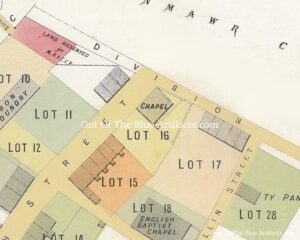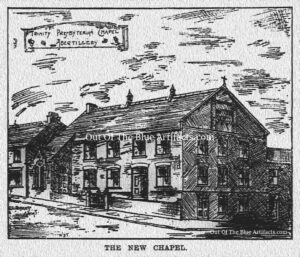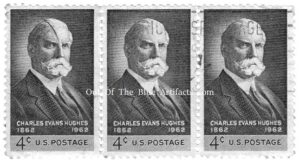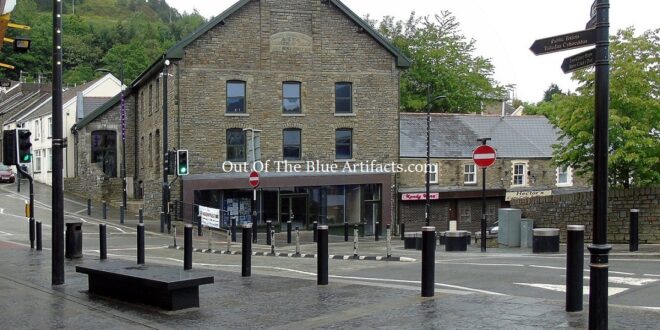 Trinity English Calvinistic Methodist Chapel.
Trinity English Calvinistic Methodist Chapel.
The original Trinity English Calvinistic Methodist Chapel at Church Street, Abertillery, (as seen center on the 1879 land sales map) was built in 1877. I had previously stated it was built in 1875 as stated in the South Wales Gazette report dated November 1905, although I have now amended this date as seen below.
New information taken from the Cardiff Times newspaper dated Saturday the 20th of October 1877, suggests the foundation stone of the English Calvinistic Methodist Chapel (Trinity) was laid on Monday 15th of October 1877 by one of its founders Mrs Jane Jones. The sum of £20 was laid on the stone by this kind beneficent lady and it was said that all collections made during the day had amounted to nearly £50. The following ministers were present – Professor Howells of Trevecca College; E. Williams, B.A.; D. P. Davies of Newport; R. Herbert; E. Davies; A. Davies of Rhymney; J. V. Jones of Llanelly and A. Edmunds of St Mellons.
Mrs Jane Jones was the first postmistress at Abertillery, the wife of Mr Edward Jones postmaster. Mrs Jones was also a founder of the Carmel Chapel, Carmel Street, Abertillery.
The Revival.
In 1904 as a result of the recent revival in religion, the Trinity English Calvinistic Methodist Society at Abertillery decided to undertake a large expansion scheme. Before the revival their roll book showed 103 members, after the revival their numbers increased to 250. In addition to the chapel the Sunday School flourished with over 350 names on the books. In order to cope with this increase they realised the necessity not only of providing a much larger chapel but also better accommodation for its Sunday School work, such as the Band of Hope and Christian Endeavour groups.
The New Chapel Proposal.
In 1904 the architect Mr R. L. Roberts of Cwmcarn was approached in connection with the construction of a new chapel. Mr Roberts planned that the existing chapel be doubled in size and to provide schoolroom accommodation underneath.
 The New Trinity Chapel.
The New Trinity Chapel.
On Monday 20th of November 1905, the stone laying ceremony at the new Trinity English Calvinistic Methodist Chapel took place. The pastor Rev Jenkins presided over the ceremony with Alderman T. H. Howell J.P. of Newport.
Master David Nathan Rocyn Jones, the son of Doctor Rocyn Jones was given the honour of laying a stone, his grandmother had laid the original stone 30 years previously. Master D. N. R. Jones had been given a silver trowel encased in a leather wallet as a memento of the occasion. Dr Rocyn Jones made a speech along with the Alderman S. N. Jones. Later a tea was provided in the vestry and in the evening a meeting was held at the Carmel Chapel Abertillery.
The Official Re-Opening of the Chapel.
On Sunday 26th of February 1906, the Trinity English Calvinistic Methodist Chapel, Church Street, Abertillery was officially re-opened. Rev D. L. Jenkins preached in the morning with the evening service being conducted by the Principal Prys M.A of Trevecca College. The choir was conducted by Mr W. Powell and accompanied by Mr Howard. The service carried on over the next few days and over £100 was raised during the week.
Description of the Building.
The building was faced with blue pennant stone, with Forest of Dean stone dressings. The chapel was approached by a spacious entrance lobby which was connected to the main body of the chapel and the galleries. The choir was accommodated behind the pulpit where an organ loft was provided. The chapel accommodated 700 worshippers and the seating was of pitch-pine, the ceiling was boarded with panels and mouldings. In addition to the vestry there were six classrooms, each accommodating twenty pupils were provided beneath the chapel. All classrooms were divided with folding partitioning to make a large spacious lecture room if needed.
The Contractor and Architect.
The contractors were Messrs Skidmore & McWhirter of Abertillery. The architect was Mr R. L. Roberts. The new building cost £2,000. The pastor was Rev D. L. Jenkins, it was his seventh year in the pastorate at Abertillery. It was noted that with the exception of the Blaenau Gwent Baptist Chapel the site at the Trinity Chapel was the only freehold site held by any Free Church in the district.
Messrs Skidmore & McWhirter.
Mr Edward Skidmore and Mr Peter McWhirter were building contractors based in Six Bells. Mr Edward Skidmore, a stone mason was from Milton-Under-Wychwood, he came to Abertillery in about 1896 and initially lived in Vivian Street, the family moved into Alma Street, Abertillery and named their house there Wychwood House after the place where the family originally lived, Milton-Under-Wychwood, near Burford in Oxfordshire.
The building partnership of Skidmore & McWhirter began and the pair constructed many houses, churches and chapels etc in and around Abertillery and Six Bells. In about 1906 Mr Skidmore built a new home for himself and family at the bottom of Eastville Road, Six Bells and also named it Wychwood House, after the place where the family originated. Mr Peter McWhirter lived in Toronto House, Alexandra Road, Six Bells.
Apart from the many houses they constructed, Messrs Skidmore & McWhirter also had the contracts to build the new Trinity Chapel, Church Street Abertillery in 1905, constructed the new Bethany Church, Six Bells in 1905 and in 1906 they renovated the Ebenezer Chapel, Abertillery. Later the pair built the Alexandra Buildings at Six Bells and the Alexandra Skating Rink which was later converted into the Kino Cinema Picture House. After selling off the skating rink with Mr Edward Skidmore, Mr Peter McWhirter left the area in 1913 and sold his Toronto House premises on Alexandra Road. Mr Edward Skidmore left Abertillery in 1918 to reside at Weston-Super-Mare.
Pupil Teacher Classes at the Trinity Chapel.
Just after the chapel had been re-built the Director of Higher Education, Mr Badger, reported that acting on the instructions of Alderman S. N. Jones he had arranged for the use of the Trinity Chapel vestry for the new joint central pupil and teacher classes at Abertillery. The terms were – Rent £40 per year which included coal, gas and cleaning of the hall.
The Closure of the Trinity Chapel.
In August 1949 the Trinity Chapel was closed as a chapel, it was proposed that the council purchase it and for the building to be turned into a public library for the town. Owing to a lack of interest shown by the council in the proposal the Trinity Chapel building was sold by the presbytery in the mid 1950’s to Messrs Joseph & Falkman a furniture retailer to be used as their showrooms.
The Later Years.
Over the years the building was converted, retailers used and occupied the ground floor and the premises around the chapel were called the Trinity Buildings. The chapel became derelict and is recently undergoing extensive alterations.
Notes of Interest – Mrs Jane Jones.
Mrs Jane Jones 1822-1903 was one of the oldest inhabitants of Abertillery, she was one of the founders of the Carmel Calvinistic Methodist Church at Abertillery and the Trinity Chapel as mentioned, she had laid many foundation stones in connection with the various churches and was one of the most successful businesswomen in the district. She left Abertillery to live at Maesycwmmer in 1896. In February 1903 she came back to visit her son Mr S. N. Jones, fell ill and on Monday 16th March 1903 she sadly passed away.
Mrs Jane Jones nee Hughes, the first postmistress at Abertillery was the sister of Mr Nathan Hughes of Six Bells and Aberbeeg, Abertillery. Mr Nathan Hughes’ son was Rev David C. Hughes who emigrated to the U.S.A. and was the foremost Baptist Minister in America. Mr David C. Hughes had a son Mr Charles Evan Hughes became a very successful U.S. politician (as seen below) on a set of postal stamps from the U.S.A.
 Mr Charles Evan Hughes 1862-1948 (as seen in the image left) was born at Glen Falls, New York in 1862, described as being the son of the Welsh immigrant Mr David C. Hughes and the American Mrs Mary Hughes nee Connelly, a sister of the State Senator Mr Henry C. Connelly. Mr Charles Evan Hughes became a lawyer, statesman and politician. On the 6th of November 1906 he defeated Mr William Randolph Hearst to become the Governor of New York State and in 1916 he ran against Mr Woodrow Wilson in the U.S.A. presidential elections, being defeated on this occasion by the more experienced candidate.
Mr Charles Evan Hughes 1862-1948 (as seen in the image left) was born at Glen Falls, New York in 1862, described as being the son of the Welsh immigrant Mr David C. Hughes and the American Mrs Mary Hughes nee Connelly, a sister of the State Senator Mr Henry C. Connelly. Mr Charles Evan Hughes became a lawyer, statesman and politician. On the 6th of November 1906 he defeated Mr William Randolph Hearst to become the Governor of New York State and in 1916 he ran against Mr Woodrow Wilson in the U.S.A. presidential elections, being defeated on this occasion by the more experienced candidate.
Mrs Jane Jones’ son was Mr Samuel Nathan Jones, J.P and councillor. Mr S. N. Jones also became a county councillor had a grocery and provisions business and premises close to the Arcade Abertillery. Mr Jones’ grocery shop was on the corner of the Arcade and in Commercial Street. It was originally a grocers and post office, which was transferred there after the closure of the office at the railway-platform near or at Pond House. Mr Samuel Nathan Jones was responsible for the construction of the Abertillery Shopping Arcade in the late 1890’s and had a daughter Miss Alla Jones, she later married Mr David Rocyn Jones the collieries doctor.
 Out Of The Blue Artifacts A Library of a lifetime of collecting
Out Of The Blue Artifacts A Library of a lifetime of collecting
